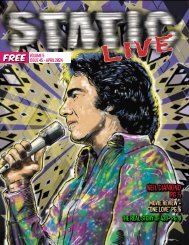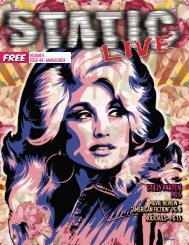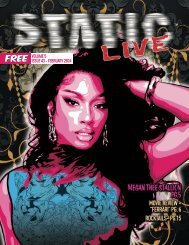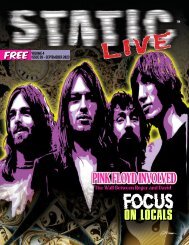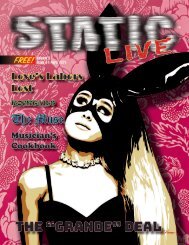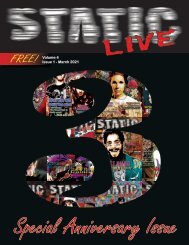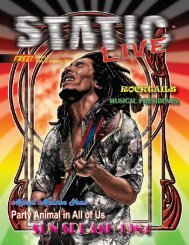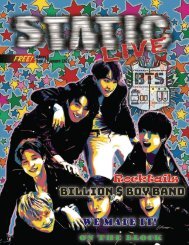Static Live Magazine February 2019
Create successful ePaper yourself
Turn your PDF publications into a flip-book with our unique Google optimized e-Paper software.
Appetite for the Blues<br />
By Mark “Muddyharp” Hodgson<br />
Old Crow Medicine Show, “Tell It to Me”<br />
“Now won’t you tell it to me<br />
Tell it to me<br />
Drink the corn liquor let the cocaine be<br />
Cocaine’s gonna kill my honey dead<br />
All them rounders think they’re tough<br />
But they feed their women on beer and snuff<br />
Cocaine’s gonna kill my honey dead”<br />
A rounder has a few different connotations. The one in the Old<br />
Crow Medicine lyric depicts someone who sounds like a kind of<br />
a complicated character. Another definition refers to a person<br />
who “rounds the edges” on a piece of lumber. Considering the<br />
many lumber camps in Florida at the turn of the 20th century, I<br />
think it is safe to say a combination of the two definitions might<br />
be appropriate when speaking of a typical African American<br />
bluesman in Florida back in those days.<br />
“If you understand the music, you understand how much time<br />
it takes to get anywhere close to being a good player. Then you<br />
come to the reality of how you can you get people to hear you<br />
once you sound ok. Then you come to grips with the fact music<br />
is being paid for in nightclubs. You can actually make money<br />
playing music in nightclubs. One thing leads to another and<br />
after a time you are ready to make a record.”<br />
Gabriel Brown is journeyman blues artist who spent most of<br />
his time in Florida. He was born in 1910 in Gadsden County.<br />
Attended Florida A&M and in 1934 he performed at the first<br />
National Folk Festival in St. Louis, Missouri. He was discovered<br />
by folklorist Zora Neale Hurston who contacted Alan Lomax<br />
who then recorded Mr. Brown for the Library of Congress in<br />
1935. Brown’s career was varied. He was part of a Miss Hurston<br />
light Opera called “Polk County” which ran in New York City and<br />
toured with the Florida Arts Theatre under the direction of Orson<br />
Welles. His first commercial recording for Flyright Records<br />
in 1943, showed Mr. Brown in a variety of styles. He was known<br />
as a songster defined by the influences and alternate picking<br />
Piedmont style of guitar playing and vocals. The Piedmont style<br />
leans more toward Jimmie Rodgers (the singing brakeman),<br />
than say, Son House.<br />
Mr. Brown disliked performing nightclubs. “Too many rounders<br />
and things going on in them night spots. They don’t care<br />
about no music ‘cept if it helps somebody get over.” I did have<br />
a guy showed me some chords on the guitar. Just give him a<br />
taste of gin and he would be all mellow and patient and show<br />
me things, he helped me a lot. Most them old timers knew the<br />
blues... just give ‘em a little taste!”<br />
I like Gabriel Brown. I think, even though he never became a<br />
big star, he kept it together in his real life and his music was<br />
more Florida because of all the influences in his sound. He<br />
could lay down 12 Bar blues all night long but he also sang<br />
‘hits’. This is his strength. Gabriel Brown was a real Florida bluesman.<br />
Library of Congress discography:<br />
-John Henry (355-A)<br />
- John Henry (instr.) (355-B)<br />
- Blues (357-B) #<br />
- Tone The Bell Easy (358-A-1)<br />
- The Motherless Child (358-A-2)<br />
- A Dream Of Mine (359-A)<br />
- Education Blues (360-A) #<br />
- Talking In Sebastapol (360-B)#<br />
- Careless Love (361-A)<br />
rec. late (poss. 20) June, 1935 in Eatonville, FL by Elizabeth<br />
Barnicle, Zora Neale Hurston, & Alan Lomax; Gabriel Brown, voc,<br />
g; # Rochelle French, g<br />
Library of Congress<br />
Unissued<br />
Flyright-Matchbox<br />
SDM 257<br />
Florida isn’t Mississippi. The Mississippi River, it’s delta and<br />
tributaries are unique. The music that comes out of that entire<br />
region could not be made anywhere else. The Florida state of<br />
mind is transitory and adaptive. Florida naturally absorbs and<br />
redistributes all the energy it receives. So, many different type<br />
of people end up here as did the blues which found its way to<br />
Florida as a transplant from someone looking for a better life.<br />
“I’m a rake and a rambler and an old time rounder too<br />
I can tell tales to ladies and I can sing the blues for you<br />
I don’t know where I’m heading but I can tell you where I’ve<br />
been<br />
I’ve been down to Florida just to see an old friend.”.....-1924<br />
artist unknown<br />
Next month Florida Blues “ Swamp” ( part 3)<br />
34<br />
static-magazine-template Feb 19.indd 34<br />
<strong>2019</strong>-01-28 1:28:40 PM





